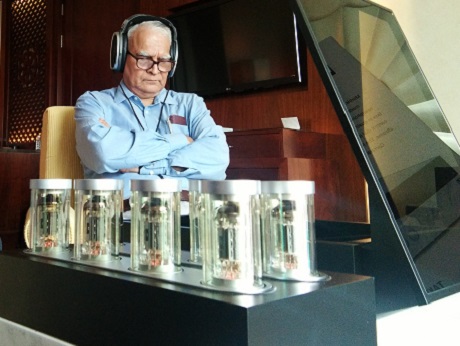
By Anand Parthasarathy
Bangalore, September 5 2018: That rare look of trance-like concentration on my face in the photo is because I am trying out the Sennheiser HE1 -- the world's finest headphone audio system -- at the company's recent roadshow in Bangalore.
The amplifier in the foreground is encased in Carara marble from Italy to isolate the parts from vibration. The decoupling of the tubes in combination with the damping properties of the marble has the effect of reducing structure-borne noise to an absolute minimum.
The tubes you see on top are old fashioned vacuum tubes that do the first stage amplification. The headphones I am wearing contain the second stage amplifier ( just in case something is lost in the cables).
Back to vacuum tubes
The headphones use a completely new amplifier concept that combines the superior impulse processing of a tube amplifier with the low distortion of a transistor amplifier to perfection. Eight vacuum tubes that process the incoming signal. The tubes themselves also have a high-quality patent-pending enclosure consisting of quartz-glass bulbs that perfectly shield them from their surroundings.The decoupling of the tubes in combination with the damping properties of the marble has the effect of reducing structure-borne noise to an absolute minimum. The tubes themselves also have a high-quality patent-pending enclosure consisting of quartz-glass bulbs that perfectly shield them from their surroundings.
The tube amplifier stage is followed by a patented ultra-high impulse amplifier stage that is directly integrated into the cups of the headphones. The result is impressive: a 200 percent rise in efficiency compared to other products. The advantage of this design is the extremely short distance between the amplifier and the diaphragm, which is less than one centimetre. As a result, the headphone system requires far less power for charge reversal, as the current capacities are much lower. At a voltage of only around 5 Volt, the music signal is transmitted balanced to the high-voltage amplifier integrated into the headphones and is amplified there. This ensures extremely high impulse fidelity with relatively low power requirements.
Each of the more than 6,000 individual components was carefully chosen, their acoustic characteristics: For example, to ensure the outstanding performance of the acoustic unit, Sennheiser uses gold-vaporised ceramic electrodes and platinum-vaporised diaphragms.
When developing the electrodes, the aim was to find a material that is absolutely rigid in order to avoid the possible occurrence of distortion peaks at frequencies in the range of three to four kilohertz. Against this background, the engineers finally decided to use ceramic – a material whose internal damping and granular structure make it much more resistant to resonances than, for example, glass. However, producing such ceramic electrodes turned out to be a complex task: ceramics can neither be etched nor suitably drilled. For that reason, Sennheiser crafted the electrodes using a sophisticated spraying and grinding process. Subsequently, a layer of gold was vapor-deposited to guarantee optimum electrical conductivity.
The eight wires of the high-performance cables are made of oxygen-free copper and plated with a coating of silver, which provides optimum conductivity for perfect transmission of the audio signal. The wires are sheathed in an insulating layer that has a mixture of differently structured materials which eliminates the sound waves acting on the cable.
8 Hz to 100 Khz.. range beyond human hearing
The Sennheiser HE 1 has a frequency response of 8 hertz to more than 100 kilohertz. This is a frequency range which far exceeds the limits of human hearing ability. At one kilohertz and a sound pressure level of 100 decibels, the total harmonic distortion of the headphone system is a mere 0.01 percent, which means it reproduces the sound of the audio source with greater fidelity and in more detail than any other product in the audio world.
The Sennheiser HE 1 can be operated with a wide range of analogue and digital audio sources.
10 year task
Taking 10 years and a money-no-constraint mandate, German engineers at Sennheiser, created a headphone system that they manufacture at just one a day on pre orders and they are said to be pre-booked for months ahead. The asking price? US $ 55,000 -- or Rs 45 lakhs approx.
Says Sennheiser CEO Daniel Sennheiser. “With the Sennheiser HE 1, we are once again pushing the boundaries and are showing that we can repeatedly set new benchmarks in excellence and reshape the future of the high-end audio world.”
Adds Kapil Gulati, Director Consumer Segment, Sennheiser India: “We are very excited to have launched the Sennheiser HE1 in India. It sets an all-time high benchmark in the audio industry. The sound quality and experience is truly mesmerising and we hope for a good result in the Indian market”
And how does it sound? The closest I could find in the play list that came with the headphones ( other than modern rock and pop that I can't stand) was a Vivaldi harpsichord concerto. Eyes closed, it felt like you were seated next to the conductor, with string and wind sections palpably separate...you could nearly "touch" the harp soloist every time the instrument kicked in.... Creepy -- and divine.